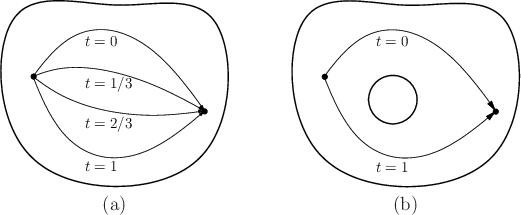
Next: Groups Up: 4.1.3 Paths and Connectivity Previous: Connected vs. path connected
Now that the notion of connectedness has been established, the next step is to express different kinds of connectivity. This may be done by using the notion of homotopy, which can intuitively be considered as a way to continuously ``warp'' or ``morph'' one path into another, as depicted in Figure 4.6a.
 |
Two paths ![]() and
and ![]() are called homotopic (with endpoints fixed) if there exists a continuous function
are called homotopic (with endpoints fixed) if there exists a continuous function
![]() for which the following four
conditions are met:
for which the following four
conditions are met:
During the warping process, the path image cannot make a discontinuous
jump. In
![]() , this prevents it from moving over holes, such as
the one shown in Figure 4.6b. The key to preventing
homotopy from jumping over some holes is that
, this prevents it from moving over holes, such as
the one shown in Figure 4.6b. The key to preventing
homotopy from jumping over some holes is that ![]() must be continuous.
In higher dimensions, however, there are many different kinds of
holes. For the case of
must be continuous.
In higher dimensions, however, there are many different kinds of
holes. For the case of
![]() , for example, suppose the space is
like a block of Swiss cheese that contains air bubbles.
Homotopy can go around the air bubbles, but it cannot pass through a
hole that is drilled through the entire block of cheese. Air bubbles
and other kinds of holes that appear in higher dimensions can be
characterized by generalizing homotopy to the warping of
higher dimensional surfaces, as opposed to paths [439].
, for example, suppose the space is
like a block of Swiss cheese that contains air bubbles.
Homotopy can go around the air bubbles, but it cannot pass through a
hole that is drilled through the entire block of cheese. Air bubbles
and other kinds of holes that appear in higher dimensions can be
characterized by generalizing homotopy to the warping of
higher dimensional surfaces, as opposed to paths [439].
It is straightforward to show that homotopy defines an equivalence
relation on the set of all paths from some ![]() to some
to some ![]() . The resulting notion of ``equivalent paths'' appears
frequently in motion planning, control theory, and many other
contexts. Suppose that
. The resulting notion of ``equivalent paths'' appears
frequently in motion planning, control theory, and many other
contexts. Suppose that ![]() is path connected. If all paths fall into
the same equivalence class, then
is path connected. If all paths fall into
the same equivalence class, then ![]() is called simply
connected; otherwise,
is called simply
connected; otherwise, ![]() is called multiply
connected.
is called multiply
connected.
Steven M LaValle 2020-08-14